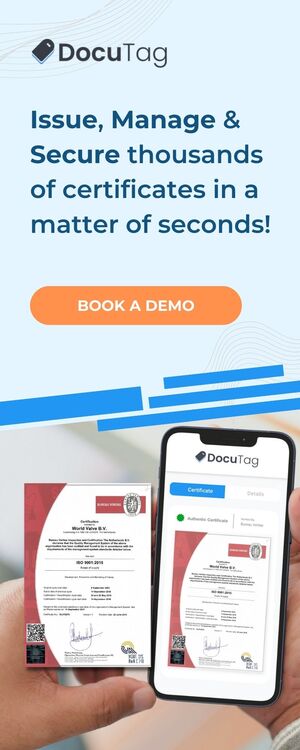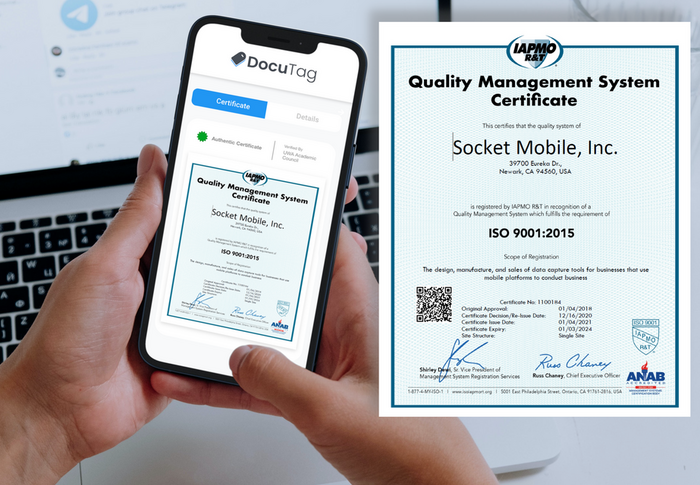You may not be familiar with the term Product Citizenship yet, but it is a concept that can help in protecting and promoting a product of a brand by giving an identity or ‘citizenship’ to every single product. This citizenship allows a product to prove its authenticity and provide exhaustive information by itself. Read more on Product Citizenship here.
Smart packaging is an excellent way business owners can prove their brand’s authenticity, establish consumer trust and encourage better consumer engagement by eliminating all the doubts, perhaps even suspicions about its authenticity. It is mainly divided into two types; active and intelligent packaging.

Image source: https://www.youtube.com/watch?v=jdpIBK7BsSo&ab_channel=TheCoca-ColaCo.
Other brands like Coca-Cola, which have already used smart packaging for their brands to enhance consumer engagement, show product authenticity and provide relevant supply chains. Brand owners do not have to worry about their product, they should let the product do the work for them with smart packaging instead.
How to implement Active Packaging

Figure 1: Active and Intelligent packaging classification and their main properties
Active Packaging is a method to improve or communicate the quality of products, particularly food, without needing any interaction from the customers. Reviewing a product already implementing active packaging can make it easier to comprehend this concept.
-
Identifying your objective
In choosing the type of active packaging for your product, you have to rule out your main goal; whether to improve the quality of it such as prolonging the lifespan, or to communicate the condition of the products, which is especially helpful for food products, or both! Well, if you have the appropriate budget.
Taking the case of Kembara meals, they implemented active packaging to improve the quality and functionality of their products. They produce self-heating ready-to-eat meals that have a shelf life of two years without any preservatives. Targeting mountaineers, the packaging of Kembara products was chosen to be extra durable, able to lock moisture and withstand heat while at the same time efficiently transfer heat from the heating element to the food.
An active packaging that communicates information, on the other hand, uses material that may change upon certain conditions, such as temperature and the amount of air in the packaging. For example, the Coca-Cola company in Australia had produced a bottled drink that changes color when it is cold. Other than that, you can also commonly find milk packs or canned food that warned the customers to not consume the product if the cap is bloated.
-
Availability of resources
As you can see, the key aspect of active packaging is the choice of material. So, if you would like to implement active packaging for your products, you may want to look for manufacturers that can provide such materials that fit your needs, for example, can inhibit microbial growth or prevent loss of moisture. In choosing the materials, take into consideration whether the production cost is worth the returned profit
How to implement Intelligent Packaging
Although falling under the same category of smart packaging, Intelligent packaging is different from Active packaging. While active packaging functions by itself, intelligent packaging allows the product to record information in which a person can extract the information by following instructions provided on the packaging. In simpler words, intelligent packaging allows a product to sense and inform.
-
Choosing the type of tagging
The most common form of intelligent packaging is the application of QR (Quick Response) code or NFC (Near Field Communication) tagging. RFID (Radio Frequency Identification) tagging is also one of the commonly used smart packaging, usually used for supply chain management and pet tracking.
QR code is an advanced version of barcode, whereby it can be scanned at any angle, and can still deliver information when the code takes damage up to 30%. Currently, there are many free QR code generators online, and with the advancement of technology, a QR code can be conveniently scanned with any smartphone with a camera, as long as it has a QR code scanner application installed from Google Play Store or Apple App Store.
However, the free version is usually a static type QR code, whereby it only redirects a scanner to a URL or website pages. If you want the QR code to contain modifiable information and be able to return information to you, such as the number of times being scanned and the location of scanning, you might want to consider a paid subscription of dynamic QR code.
Unlike QR code, NFC and RFID tagging require a physical device which means they cannot be implemented for free. NFC can only interact with another device that also has NFC installed, whereby RFID can only be read by special scanners with additional security concerns. So, if you are targeting a mass audience, you may want to put a QR code on the top of the product.
-
Setting up the system
The choice of tagging is only the first step of intelligent packaging. The main function of intelligent packaging is allowing the end-users to interact with the product by triggering a certain action. So, you must ensure that when they do trigger the actions, they will receive the information. You must invest adequate resources to prepare the contents for the users, such as your brand’s webpage, a tutorial YouTube video, or a blockchain-powered system that can prove the authenticity of your products.
How to make smart packaging boost your brand
While smart packaging could boost up the sales of every business owner and leave an impression that a product is up to date, bear in mind that how beneficial it is to the growth of your brand heavily depends on how brand owners make it useful. There’s no use of powerful smart packaging if the information it redirects to doesn’t impress the customers, hence, brand owners need to know how to catch the attention of their potential customers by putting precise information on the products themselves. To make smart packaging boost your brand, these are some things you should consider:
-
Build brand identity
Smart packaging helps to build brand identity or product citizenship by itself. When considering packaging materials, business owners should acknowledge the consumer perception towards the product, whether it reflects the brand’s identity or not. For example, if you claim that you support the conservation of the earth, then use eco-friendly materials for your packaging. By doing this, customers can more effectively connect the product and its packaging with the brand and in turn, create trust and loyalty which will contribute to the sales of the product.
-
Make it convenient for consumers
Smart packaging gives consumers more access to information, hence it allows consumers to make more smart and sustainable decisions, unlike other mainstream labeling methods. To ensure it, you must make the customers aware of the usage of smart packaging while providing adequate instructions and incentives for the consumers on the labeling of the product. When consumers feel satisfied and empowered with purchasing your product, it indicates that you have successfully filled their needs through smart packaging.
-
Be consistent
Consistency is key in every business for them to succeed. As a business owner, you need to ensure that the quality of your product, your business’ website, and related systems such as the blockchain system, to be on par with the product packaging. The contents across the different platforms must be up to date to deliver the expectation of the customers. When consumers see consistency in managing the product, the website, and also the blockchain system, they will be more convinced with the originality, security, and quality of your product, consequently turning them into loyal customers of your brand.
Let BrandTag do the work for you!
All in all, big companies like Amazon and Coca-Cola have already adapted smart packaging into their businesses, so if you want to follow in their footsteps, you should also start implementing smart packaging! Just recapping, Smart Packaging helps to protect your brand from losses resulting from counterfeit and let the products promote your brand by themselves, which will inevitably make the arrow on your revenue chart spike upwards.
On the other hand, even though smart packaging is powerful and indeed convenient for both consumers and brand owners, it requires a lot of effort and resources to make it successful, especially if your brand is a start-up. Implementing smart packaging could be “bumpy”, or worse, can hamper your brand’s reputation if not done correctly. Alternatively, you can also focus all your resources on more crucial parts of your brand development and ‘hire’ someone or software to do all the “hard work” for you: software like BrandTag.

Figure 2: BrandTag picture
BrandTag is a SaaS (Software-as-a-Service) solution that helps business owners to secure their products by giving each product a unique identity with the application of blockchain technology. which ultimately ends in helping consumers to trace the authenticity of products belonging to a given brand. In fact, BrandTag allows a consumer to interact with you as the brand owner directly without any mediator. All of these features come in one package. That means you don’t have to hustle updating and synchronizing different platforms anymore! It is also easy to be learned, which can save a lot of time and money for trying to learn the system alone. With BrandTag to the rescue, it helps business owners to implement smart packaging like never before. Learn more about BrandTag here.
Let your product do the work for you.
Combating counterfeiters is exhausting, we get it. That’s why we developed BrandTag. With BrandTag, your products will promote their authenticity and protect themselves from being counterfeited, with just a scan!






